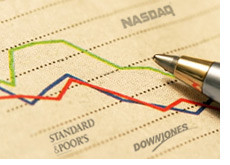All Three Major North American Market Indexes Down Over the Last Decade
 The past ten years have been decidedly horrible in the United States when it comes to the equity markets.
The past ten years have been decidedly horrible in the United States when it comes to the equity markets. The DJIA (Dow Jones Industrial Average), NASDAQ and S&P 500 are all lower today (September 16th, 2009) than they were on September 16th, 1999.
The DJIA closed on 09/16/1999 at 10,737.46 - today it closed at 9,791.71.
The NASDAQ closed on 9/16/1999 at 2,806.72 - today it closed at 2,133.15.
The S&P 500 closed on 9/16/1999 at 1,299.77 - today it closed at 1,068.76.
If it weren't for a significant 50% rally off of the March lows earlier this year, the difference between September 1999 and September 2009 would be even more dramatic.
So what does this mean?
It means that the average investor in US equities (via stock purchases, mutual funds, etc) is very likely down over the past 10 years.
It means that $1 invested in the US markets in September of 1999 is worth less than $1 today.
Given the way that the markets performed in late 1999 / early 2000, it seems almost inconceivable that somebody who invested in the fall of 1999 would actually be in the red.
Given the way that the DJIA soared in 2006-2007, it seems almost absurd that an investor would have actually lost money if they had invested back in September of 1999.
But it's the truth.
These are negative returns in real dollars, and that stings by itself.
However, when you take into account inflation, the returns are even more painful.
$1 of 1999 dollars is worth $1.29 of 2009 dollars.
So let's say that you invested $10,000 in an S&P 500 index fund in September of 1999.
The S&P 500 index has dropped 17.8% over the past ten years, meaning that your investment is currently worth around $8,222.00.
Sounds bad, right?
It gets even worse.
Investment gains need to outpace inflation, or else what's the point of investing in equities?
$8,222.00 of 2009 dollars is only worth $6,331.46 of 1999 dollars.
So, adjusting for inflation, your $10,000 investment in the S&P 500 is only worth $6,331.46, which is a drop of almost 37%.
Many people forget about inflation when they are tabulating their investment losses over the past decade.
Sure, your portfolio is down substantially since 1999, but your dollars also have significantly less buying power.
A $10,000 investment in a DJIA index fund is currently worth approximately $9,120 in real dollars, which translates into around $7,022 in inflation-adjusted dollars.
A $10,000 investment in a NASDAQ index fund is currently worth around $7,600 in real dollars, which translates into an abysmal $5,852 in inflation-adjusted dollars.
--
1999 was a year in which many Americans came to the conclusion that they HAD to be invested heavily in the equities markets.
CNBC became must-watch TV, and the stock markets became part of the mainstream consciousness.
Even when the dot-com bubble burst in 2000, many Americans remained heavily invested in the equities markets, even if they weren't as captivated as they had been in 1999.
With a decade of negative returns staring them in the face, will Americans continue to invest in mutual funds and stocks?
Will Americans continue to throw the type of money into the markets that is necessary to fuel another big bull market? Or have they been permanently damaged by the past ten years?
An even more important question - will members of "Generation X" and "Generation Y", who will be entering their prime earning years over the next decade or two, remember the heartbreak of the past ten years and refrain from investing heavily in the markets?
People who lived through the "Great Depression" still, for the most part, live a frugal lifestyle and are wary of investing in the markets.
Will younger people who lived through the "Great Recession" have the same type of apprehension about investing in the markets? It's very possible, and this could have a distinct impact on equities markets over the next 10-30 years.
Filed under: The Economic Meltdown



